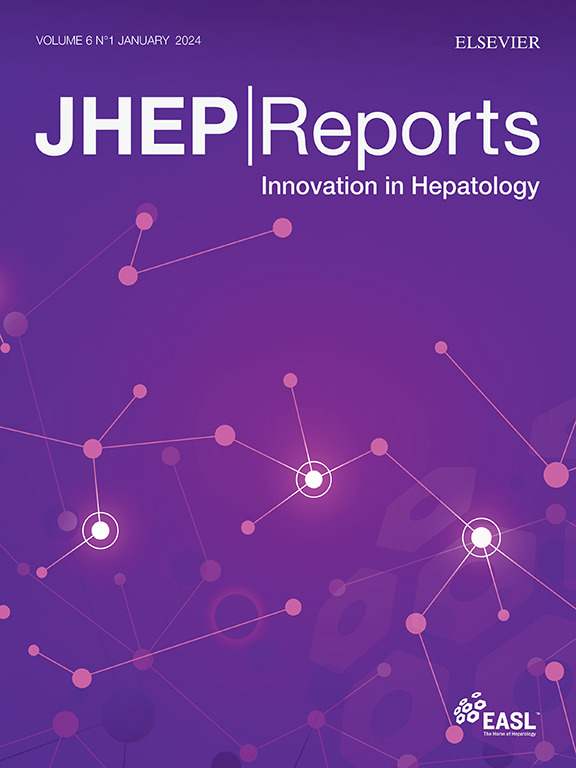早期肝细胞癌的多中心MRI及超声诊断评价
IF 9.5
1区 医学
Q1 GASTROENTEROLOGY & HEPATOLOGY
引用次数: 0
摘要
背景,目的:缩短核磁共振(AMRI)已被提议作为超声监测肝细胞癌(HCC)的替代方案;然而,需要AMRI和超声的比较数据。因此,我们评估了动态对比增强(DCE)-AMRI和超声在肝硬化患者早期HCC检测中的敏感性和特异性。方法我们在肝硬化患者中进行了一项多中心回顾性病例对照研究(米兰标准的早期HCC患者;在2012年至2019年的6个月内接受超声和DCE-MRI检查的对照组(无HCC)。85%的患者仅通过影像学确诊,15%的患者通过组织病理学确诊。通过选择相关序列,从全MRI模拟动态AMRI检查。使用肝脏成像报告和数据系统算法对超声和AMRI结果进行独立、盲法解释。如果检测到US-3观察值,则认为超声检查呈阳性。如果检测到LR-4、LR-5或LR-M,则认为AMRI呈阳性。估计每个患者早期HCC检测的敏感性和特异性,并测试跨模态差异。结果纳入病例216例,对照组432例。AMRI的患者水平敏感性和特异性明显高于超声:80.1% (95% CI 76.1-83.6) vs. 71.1% (95% CI 66.6-75.2), p <0.001; 91.9% (95% CI 89.9-93.5) vs. 72.3% (95% CI 69.3-75.2), p <0.001。Child-Pugh B肝硬化患者的AMRI敏感性显著高于超声(80.8%比57.4%,p <0.001),但Child-Pugh A肝硬化患者(84.7%比78.6%,p = 0.07)或Child-Pugh C肝硬化患者(52.6%比68.4%,p = 0.18)的AMRI敏感性则显著高于超声。结论与超声相比,动态AMRI对肝硬化患者早期HCC的检测可能更敏感和特异性,尽管其在Child-Pugh A型肝硬化患者中的相对获益可能较小。需要更大的直接比较数据集,特别是在Child-Pugh C型肝硬化患者中,他们可能受益于其他监测策略。影响和意义缩短核磁共振成像(AMRI)越来越被认为是肝细胞癌(HCC)监测的替代方法。然而,现有的数据受到单中心样本、光谱偏倚和缺乏AMRI与超声比较数据的限制。我们发现,与超声相比,AMRI在检测早期HCC方面具有更高的每位患者敏感性和特异性,尽管其在Child-Pugh A型肝硬化患者中的相对获益可能较小,并且两种方式在Child-Pugh C型肝硬化患者中的表现均不理想。如果得到充分验证,AMRI可以被采纳为HCC监测的实践指南,并作为选定亚组患者的首选替代方案。本文章由计算机程序翻译,如有差异,请以英文原文为准。

Multicenter evaluation of abbreviated MRI and ultrasound for detecting early-stage hepatocellular carcinoma
Background & aims
Abbreviated MRI (AMRI) has been proposed as an alternative to ultrasound for hepatocellular carcinoma (HCC) surveillance; however, comparative data for AMRI and ultrasound are needed. Thus, we evaluated the sensitivity and specificity of dynamic contrast-enhanced (DCE)-AMRI and ultrasound for early-stage HCC detection in patients with cirrhosis.
Methods
We conducted a multicenter retrospective case–control study among patients with cirrhosis (cases with early-stage HCC as per Milan Criteria; controls without HCC) who underwent an ultrasound and a DCE-MRI within a 6-month period between 2012 and 2019. HCC diagnosis was confirmed by imaging alone in 85% and by histopathology in 15% of patients. Dynamic AMRI examinations were simulated from the full MRI by selecting relevant sequences. Independent, blinded interpretations of ultrasounds and AMRI results were performed using Liver Imaging Reporting and Data System algorithms. Ultrasounds were considered positive if US-3 observations were detected. AMRI was considered positive if LR-4, LR-5, or LR-M were detected. Per-patient sensitivity and specificity for early-stage HCC detection were estimated, and cross-modality differences were tested.
Results
We included 216 cases and 432 controls. Patient-level sensitivity and specificity of AMRI were significantly higher compared with ultrasound: 80.1% (95% CI 76.1–83.6) vs. 71.1% (95% CI 66.6–75.2), p <0.001, and 91.9% (95% CI 89.9–93.5) vs. 72.3% (95% CI 69.3–75.2), p <0.001, respectively. AMRI sensitivity was significantly higher compared with ultrasound among patients with Child-Pugh B cirrhosis (80.8% vs. 57.4%, p <0.001) but not among those with Child-Pugh A (84.7% vs. 78.6%, p = 0.07) or Child-Pugh C cirrhosis (52.6% vs. 68.4%, p = 0.18).
Conclusions
Dynamic AMRI may be more sensitive and specific for early-stage HCC detection in patients with cirrhosis compared with ultrasound, although its relative benefit might be smaller in patients with Child-Pugh A cirrhosis. Larger direct comparative data sets are needed, particularly among patients with Child-Pugh C cirrhosis who may benefit from alternative surveillance strategies.
Impact and implications
Abbreviated MRI (AMRI) is increasingly recognized as an alternative to ultrasound for hepatocellular carcinoma (HCC) surveillance. However, existing data are limited by single-center samples, spectrum bias, and lack of comparative data for AMRI vs. ultrasound. We found that AMRI had significantly higher per-patient sensitivity and specificity compared with ultrasound for the detection of early-stage HCC, although its relative benefit might be smaller in patients with Child-Pugh A cirrhosis, and both modalities underperformed in patients with Child-Pugh C cirrhosis. If sufficiently validated, AMRI could be adopted into practice guidelines for HCC surveillance and serve as a preferred alternative in select subgroups of patients.
求助全文
通过发布文献求助,成功后即可免费获取论文全文。
去求助
来源期刊

JHEP Reports
GASTROENTEROLOGY & HEPATOLOGY-
CiteScore
12.40
自引率
2.40%
发文量
161
审稿时长
36 days
期刊介绍:
JHEP Reports is an open access journal that is affiliated with the European Association for the Study of the Liver (EASL). It serves as a companion journal to the highly respected Journal of Hepatology.
The primary objective of JHEP Reports is to publish original papers and reviews that contribute to the advancement of knowledge in the field of liver diseases. The journal covers a wide range of topics, including basic, translational, and clinical research. It also focuses on global issues in hepatology, with particular emphasis on areas such as clinical trials, novel diagnostics, precision medicine and therapeutics, cancer research, cellular and molecular studies, artificial intelligence, microbiome research, epidemiology, and cutting-edge technologies.
In summary, JHEP Reports is dedicated to promoting scientific discoveries and innovations in liver diseases through the publication of high-quality research papers and reviews covering various aspects of hepatology.
 求助内容:
求助内容: 应助结果提醒方式:
应助结果提醒方式:


